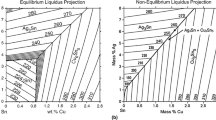Abstract
Classical physical metallurgy principles play significant roles in the pursuit of suitable substitutes for traditional lead-based solders in the electronic industry. Phase diagrams, alloy development, solidification, diffusion, wetting, aging, precipitation of second-phase particles, microstructural coarsening, temperature effects, thermomechanical behavior, and creep are among the issues to be considered. This article focuses on the importance of physical metallurgy in these developments.
Similar content being viewed by others
References
W.B. Hampshire, Soldering and Surface Mount Technology, 5 (14) (1993), p. 49.
F. Hua and J. Glazer, “Lead-free solders for Electronic Assembly,” Design & Reliability of Solder and Solder Interconnects, ed. R.K. Mahidhara et al. (Warrendale, PA: TMS, 1997), p. 65.
J.H. Lau and C. Chang, “TMA, DMA, DSC, and TGA of Lead-free Solders,” 1998 IEEE 48th Electronic Components and Technology Conference (ECTC) (Piscataway, NJ: IEEE, 1998), p. 1339.
E.R. Monsavive, “Lead Ingestion Hazard in Hand Soldering Environment,” Proceedings of 8th Annual Soldering Technology and Product Assurance Seminar (China Lake, CA: Naval Weapons Center, 1984), p. 2.
J.O. Nrigagu and J.M. Pacyna, Nature, 333 (6169) (1988), p. 134.
National Air Quality and Emission Trend Report, 1989, EPA-450/4-91-003 (Research Triangle Park, NC: Environmental Protection Agency, 1991).
W.J. Plumbridge, Soldering and Surface Mount Technology, 12 (1) (2000), p. 32.
D. Napp, Sampe Journal, 32 (2) (1996), p. 59.
A.Z. Miric and A. Grusd, Soldering & Surface Mount Technology, 10 (1) (1998), p. 19.
R.K. Govila et al., J. Electronic Packaging, 116 (1994), p. 83.
P.T. Vianco, Circuit World, 25 (1) (1998), p. 6.
G.V. Clatterbaugh and H.K. Charles, Proceedings of 35th ECTC (New York: IEEE, 1985).
Y.H. Pao et al., Fatigue of Electronic Materials, ed. S.A. Schroeder et al. (West Conshohocken, PA: American Society for Testing and Materials, 1994), pp. 60–81.
Y. Karita, Y. Hirata, and M. Ostuka, J. Electronic Materials, 28 (11) (1999), p. 1263.
N. M. Poon et al., IEEE Transactions on Advanced Packaging, 23 (4) (2000), p. 708.
K.N. Subramanian, S. Choi, and F. Guo, “Lead-free Solders with Dispersoids for High Temperature Applications,” Handbook of Lead (Pb)-free Technology for Microelectronic Assemblies (New York: Marcel Dekker, in press).
W.F. Feng, C.Q. Wang, and M. Morinaga, J. Electronic Materials, 31 (3) (2002), p. 185.
L.J. Matienzo and R.R. Schaffer, J. Materials Science, 26 (3) (1991), p. 787.
C.M.L Wu and M.L. Huang, J. Electronic Materials, 31 (5) (2002), p. 442.
D.R. Frear et al., JOM, 53 (6) (2001), p. 28.
S.K. Kang and T.G. Ference, J. Materials Research, 8 (5) (1993), p. 1033.
H. Takao and H. Hasegawa, J. Electron Materials, 30 (9) (2001), p. 1060.
C.S. Oh et al., J. Alloys and Compounds, 238 (1–2) (1996), p. 155.
F.W. Gayle et al., JOM, 53 (6) (2001), p. 17.
Z.D. Xia et al., J. Electronic Materials, 31 (6) (2002), p. 564.
F. Guo et al., Materials Science and Engineering A (in press).
J.G. Lee and K.N. Subramanian, J. Electronic Materials (in press).
J.G. Lee and K.N. Subramanian, J. Materials Research (under review).
R.J. McCabe and M.E. Fine, Metallurgical And Materials Transactions A, 33 (5) (2002), p. 1531.
K.C. Chen et al., J. Electronic Materials, 31 (11) (2002), p. 1181.
S. Choi et al., J. Materials Science: Materials in Electronics, 11 (6) (2000), p. 497.
S. Choi et al., JOM, 53 (6) (2001), p. 22.
F. Guo et al., Soldering & Surface Mount Technology, 13 (1) (2001), p. 7.
F. Guo et al., J. Electronic Materials, 30 (9) (2001), p. 1073.
H. Mavoori and S. Jin, JOM, 52 (6) (2000), p. 30.
J. Sigelko et al., J. Electronic Materials, 29 (11) (2000), p. 1307.
A.W. Gibson et al., “Issues Regarding Microstructural Coarsening Due to Aging of Eutectic Tin-Silver Solder,” Design & Reliability of Solder and Solder Interconnects, ed. R.K. Mahidhara et al. (Warrendale, PA: TMS, 1997), p. 97.
S. Choi et al., J. Electronic Materials, 28 (11) (1999), p. 1209.
J. Sigelko et al., J. Electronic Materials, 29 (11) (2000), p. 1307.
A.U. Telang et al., J. Materials Research, 17 (9) (2002), p. 2294.
S. Choi et al., J. Electronic Materials, 29 (8) (2000), p. 1249.
J.G. Lee, A.U. Telang, and K.N. Subramanian, J. Electronic Materials, 31 (11) (2002), p. 1152.
Y. Kariya, C. Gagg, and W.J. Plumbridge, Soldering & Surface Mount Technology, 13 (1) (2001), p. 39.
Y. Kariya et al., JOM, 53 (6) (2001), p. 39.
C. Herring and J.K. Galt, Phys. Rev., 85 (1952), p. 1060.
G.T.T. Sheng et al., J. Applied Physics, 92 (1) (2002), p. 64.
K. Zeng and K.N. Tu, Materials Science & Engineering R-Reports, 38 (2) (2002), p. 55.
T.Y. Lee, K.N. Tu, and D.R. Frear, J. Applied Physics, 90 (9) (2001), p. 4520.
H. Gan et al., JOM, 54 (6) (2002), p. 34.
C.M. Chen and S.W. Chen, J. Applied Physics, 90 (3) (2001), p. 1208.
S. Choi et al., J. Electronic Materials, 31 (4) (2002), p. 292.
J.G. Lee et al., J. Electronic Materials, 31 (9) (2002), p. 946.
V.I. Igoshev and J.I. Kleiman, J. Electronic Materials, 29 (2) (2002), p. 244.
Author information
Authors and Affiliations
Additional information
For more information, contact K.N. Subramanian, Michigan State University, Department of Chemical Engineering and Materials Science, East Lansing, MI 48824-1226; e-mail: subraman@egr.msu.edu.
Rights and permissions
About this article
Cite this article
Subramanian, K.N., Lee, J.G. Physical metallurgy in lead-free electronic solder development. JOM 55, 26–32 (2003). https://doi.org/10.1007/s11837-003-0242-4
Issue Date:
DOI: https://doi.org/10.1007/s11837-003-0242-4




